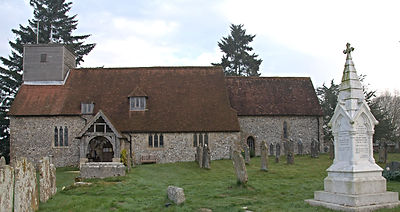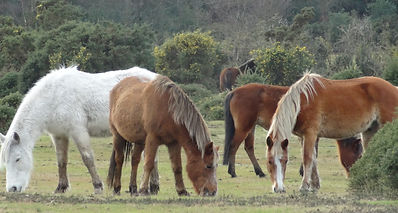
New Forest ponies on West Wellow Common


Wellow History Society

St. Margaret's Parish Church with the Nightingale family memorial
New Forest ponies on West Wellow Common
People associated with Wellow
Wellow is famous for its connection with Florence Nightingale and her family but there have been other notable people who have left their mark on the locality. In chronological order .....
Richard Norton
Richard Norton was one of the sons of Sir Daniel Norton of Southwick. The exploits of Colonel Richard Norton as a leader of a troop of cavalry on the Parliamentary side played a significant part in the defeat of the Royalists in Hampshire during in the Civil War, for example the capture of Romsey. Richard was a Hampshire M.P. from 1645 - as a 'recruiter' to the Long Parliament - until his death in 1691. During the 1660s and 1670s Richard progressively bought up parts of the manors of East and West Wellow, so that he was able to settle an estate comprising most of East Wellow (except Embley) and a large part of West Wellow on his son Colonel William Norton on the marriage of the latter in 1682. In 1700 William Norton paid rates on Pins Farm, West Wellow, and later probably lived at the Manor Farm in East Wellow – there are stories of his ghost on horseback being seen in the village years ago! After William’s death in 1703 Thomas and Charles Norton held the estate for a few years, but sold it in 1712 to George Rodney Brydges who was acting for his cousin James Brydges (later Duke of Chandos).
James Brydges, Duke of Chandos
James Brydges (1673-1744) held the hereditary title Marquess of Carnarvon and was the eldest son of James Brydges, Lord Chandos (8th Baron). From 1707 to 1712 James Brydges was Paymaster General, and through this office he earned great sums which he increased to half a million pounds by speculation. He acquired the estate of Cannons, near Edgware, Middlesex, from his first wife’s uncle in 1712 and spent a fortune on building and furnishing a great house there. He was rewarded by King George I with an earldom in 1714 and a dukedom in 1719. However, his golden touch was not infallible and he lost much of his wealth when the South Sea Company collapsed, and the house called Cannons, of which he was so proud, was sold off for its materials when he died.

A cousin of James Brydges, named George Rodney Brydges lived at Avington, near Winchester, where he had entertained royalty. When the Norton family decided to sell the ‘manors’ of East and West Wellow and advowson of the church of East Wellow in 1712, James Brydges gave his cousin the money to buy these manors. Sadly, within a year, George Rodney died of gangrene following a leg amputation, and his son George Brydges transferred the Wellow manors, and the advowson, to James, the rightful owner. James was succeeded as Duke of Chandos and Lord of the Manors of Wellow in 1744 by his son Henry who wasted many of the family assets, but retained the Wellow estates. He was in turn succeeded in both of these positions by his son James in 1772, but in his will Henry gave his widow, as Dowager Duchess of Chandos, a lifetime interest in the Wellow properties, which she retained until her death in 1813. James died in 1789 without a male heir, so his heir was his only surviving daughter Anne, who married Richard (Lord Temple) Marquess of Buckingham (and later Duke of Buckingham and Chandos). Lord Temple sold the Wellow estates to Sir William Heathcote after the death of the Dowager Duchess.
William and Thomas Heathcote

The Embley estate was bought in about 1755 by John Thorpe from Salisbury. In 1768 his daughter Frances married William Heathcote (1746-1819) of Landford Lodge, eldest son of Sir Thomas Heathcote (1721-1787) and heir to the Hursley estate. Frances and William Heathcote gained the Embley estate as their share of the Thorpe family inheritance. William and particularly his eldest son Thomas Heathcote (1769-1825) were active in the expansion and development of the Embley estate, building a monument in upper Ryedown Lane, laying out the parkland and constructing lakes (e.g. Kentford) and carriageways. William became Sir William Heathcote Bt of Hursley in 1787 on the death of his father, giving him
responsibilities at Hursley and in parliament. Among other developments in Wellow, Sir William Heathcote bought the Chandos estates comprising the whole of the remainder of East Wellow and a major part of West Wellow. Sir William and Thomas improved the housing stock of farms on the newly enlarged Embley estate, for example by rebuilding the Manor Farm. Sir William died in 1819 and the estate passed to his son (now) Sir Thomas Freeman Heathcote who survived only 6 more years.
Thomas Heathcote seemed to prefer living at Embley rather than Hursley and was probably largely responsible for the developments at Embley during the Heathcote era. He had married Elizabeth Freeman in 1799 and took her surname as his middle name. This marriage unfortunately proved childless. In a search for a substitute son Thomas attempted to adopt a nephew (who would actually have been his natural heir), but, not surprisingly, his sister-in-law would not hear of it and in response Sir Thomas Freeman Heathcote left none of his Embley estate to this nephew in his will. Instead Thomas controversially left much of his Embley property to a Thomas Heathcote Tragett (the son of his steward), whom he had adopted instead of his nephew. His inheritance later allowed Thomas Heathcote Tragett to become the owner of Awbridge Danes and, as the Rev. Thomas Tragett, the builder and first Vicar of Awbridge Church.
The Embley estate was put up for sale in 1825 by the executors of Sir Thomas Freeman Heathcote, since the diminished Heathcote fortunes could not support both Embley and Hursley estates. The whole Embley property was bought at this time by William Edward Nightingale.
William Edward Nightingale

William Edward Shore was born in 1794 and was an intelligent boy who studied for a degree at Cambridge. At the age of 21 he came into an inheritance from his uncle Peter Nightingale who had made himself a small fortune from mining lead in Derbyshire. As a result of this William changed his surname to Nightingale. A condition of the legacy was that the inheritance could only remain within William’s family after his death if he had a son to inherit it, otherwise the inheritance would pass to his sister Mary and to her son, should she have one.
In 1818 William married Frances (Fanny) Smith, whose grandfather Samuel Smith had been a wealthy banker and whose father William Smith was a well-to-do M.P. By way of a protracted honeymoon they toured the continent for three years, spending much of the time in Italy. Their first daughter was born in Naples in 1819 and was named Parthenope after the Greek name for that city. On May 12th 1820 their second daughter was born in Florence and named after that city. On their return from their tour they intended to settle into a family home at Lea Hurst overlooking the Derwent Valley in Derbyshire, but they found it cold in winter and the two girls suffered winter ailments that led Fanny to seek a warmer place to spend their winters. Embley Park was then up for sale, so William bought that as a winter home, though they still spent part of the summer at Lea Hurst.
William took an active part in the life of the area, notably as a long-serving J.P., although he failed to gain election to Parliament for the Andover constituency in 1835 – apparently because he refused to bribe the voters. He was for a time Chairman of Wellow Parish Council, a Chairman of the Romsey (Poor Law) Union, and High Sherriff of Hampshire. He supported several good causes in Wellow, notably education; he provided a cottage for the original village school and helped to provide the teachers. Later he earmarked land for the present Wellow Primary School and was planning for its construction when he died, so it was left to other members of the family to complete the work. His death occurred suddenly in January 1874, and the Embley estate passed to his sister Mary, who had married Samuel Smith, Fanny’s brother, and their son and heir William Shore Smith.
Florence Nightingale
Florence Nightingale clearly regarded Wellow as her home village. She spent most of her formative years at Embley Park in East Wellow and, although she spent much of her later adult life elsewhere, she was a frequent visitor to her family here for many years. At the end of her life it was her declared wish that she be buried here in the graveyard of the Parish Church rather than among national monuments. The simple inscription she asked for is shown on the photograph below of the family memorial in the churchyard of St Margaret’s Church in East Wellow.
Florence had been born in Italy in the city after which she was named on May 12th 1820 while her parents were on a very protracted tour of the continent. When she was five years old her father bought Embley Park and the family settled down here. She was taught with her sister by a governess until she was about ten years old, and from then on her father tutored her in a range of scholastic subjects: Greek, Latin, French, Italian, philosophy, history and (later) mathematics. There was also an extensive collection of books in her father’s library, to which she had free access. She was an attentive pupil and as a result she became a highly educated young lady, well able to converse with the wide range of learned people that she met as visitors to her family home or as fellow-travellers abroad. She was also an extremely active correspondent, constantly writing to the many members of her extended family (she had 27 first cousins and nearly as many uncles and aunts), or to other people from whom she was seeking information.


As a young adult she visited people around the parish with her mother and came to know many of the families. She was encouraged to consider helping as a teacher in the village school which her father had started, but found she did not really have the temperament for it, although she and her mother were frequent visitors to the school. Through her reading and contacts she developed the desire to train as a nurse – an occupation that had a very low, even disreputable, standing at that time – but her family would not hear of it. Eventually she managed to get permission to visit a training hospital at Kaiserwerth by the Rhine in Germany which determined her to spend a longer time there. Following this longer visit she persuaded her parents to let her accept an appointment as Superintendent at a hospital for sick “Gentlewomen” in London. The Crimean War was well under way by this time and shortly thereafter she was invited by Sidney Herbert, the Secretary at War and a family friend from Wilton, to take a party of nurses to look after wounded and sick soldiers at Scutari in Turkey. This phase of her life is well known, and her later contributions to the design and management of hospitals are also widely documented. For several decades at the end of her life she was virtually bed-ridden in London, but continued as a vigorous correspondent on medical and nursing matters.